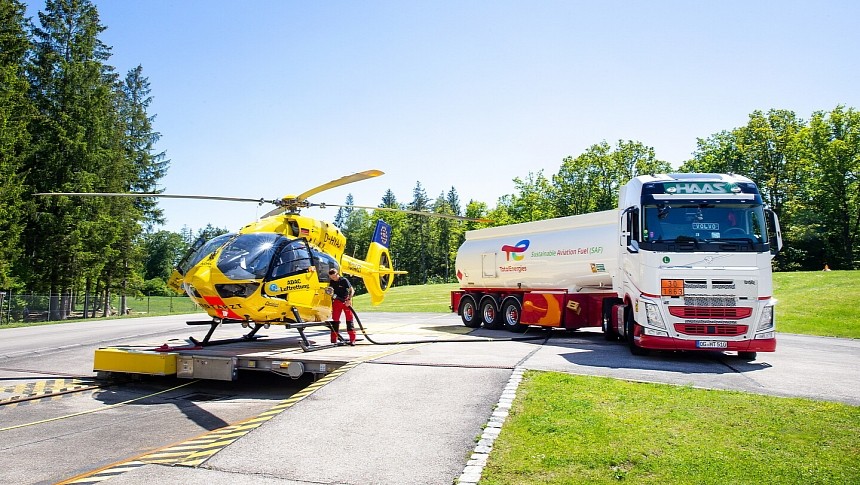Even though eVTOLs (electric vertical take-off and landing) claim to bring essential advantages compared to traditional helicopters, it's most likely that these air vehicles will co-exist for a long time. Helicopters remain unrivaled in specific domains such as search-and-rescue (SAR) missions and Emergency Medical Services (EMS). In the long run, using sustainable fuel will also make them more sustainable and eco-friendlier.
It's already been two years since biofuel powered the first rescue helicopter flight. This historic milestone was achieved in Germany in the summer of 2021. A reputable NGO named ADAC Luftrettung used a type of SAF (sustainable aviation fuel) to fuel one of its helicopters. The particular chopper was an Airbus H145 with Arriel 2E engines. The pioneering ADAC H145 used a 40% blend at the time, with biofuel made by TotalEnergies at its refinery in Normandy.
One of the most reputable EMS operators in the world, the German NGO used that milestone as a stepping stone for two complex projects. One is researching the long-term effects of this alternative fuel on the engines and the entire technology of the Airbus H145. This project is carried out with Airbus Helicopters, Safran Helicopter Engines, and DLR (the German Aerospace Center) at ADAC's air rescue base at the Cologne/Bonn Airport.
A second project started in 2022 at Aachen, using an Airbus 135 with Pratt & Whitney engines. ADAC hopes to reach 1,000 hours of SAF-powered flights for each project and gradually grow the bio-kerosene percentage to 80. It sticks to a 35% blend for now, which is still enough to drop CO2 levels by 25%.
In Ireland, a different kind of aviation operator supports using SAF for younger-generation Airbus helicopters. LCI is part of the Airbus Helicopters Sustainable Aviation Forum (SAF), focusing on industry feedback for using SAF. The Dublin-based aviation leasing company has recently added H175 helicopters to its fleet. This new-generation rotorcraft entered service in 2015 and quickly became a record-setter, smashing the world records for time to climb (3,000 meters in three minutes and ten seconds, plus 6,000 meters in six minutes and 54 seconds).
The H175 can carry up to 18 passengers, combining top-notch cabin comfort with high speed (more than 155 knots/178 mph) and a fuel tank capacity of over 2,000 kg (4,409 lbs). Earlier this year, Airbus Helicopters announced its plans to ramp up production for the H175 while preparing for 100% SAF-powered flights starting in 2026.
Airbus choppers helped advance the use of SAF beyond European borders. An Airbus H215 performed the first flight of this kind in Japan with Makila 1A1 engines. The fight occurred in the summer of 2022, using a 10% SAF blend from a Japanese biotechnology company.
By the end of the decade, we could see more conventional helicopters operating with fewer emissions thanks to green jet fuel worldwide.
One of the most reputable EMS operators in the world, the German NGO used that milestone as a stepping stone for two complex projects. One is researching the long-term effects of this alternative fuel on the engines and the entire technology of the Airbus H145. This project is carried out with Airbus Helicopters, Safran Helicopter Engines, and DLR (the German Aerospace Center) at ADAC's air rescue base at the Cologne/Bonn Airport.
A second project started in 2022 at Aachen, using an Airbus 135 with Pratt & Whitney engines. ADAC hopes to reach 1,000 hours of SAF-powered flights for each project and gradually grow the bio-kerosene percentage to 80. It sticks to a 35% blend for now, which is still enough to drop CO2 levels by 25%.
In Ireland, a different kind of aviation operator supports using SAF for younger-generation Airbus helicopters. LCI is part of the Airbus Helicopters Sustainable Aviation Forum (SAF), focusing on industry feedback for using SAF. The Dublin-based aviation leasing company has recently added H175 helicopters to its fleet. This new-generation rotorcraft entered service in 2015 and quickly became a record-setter, smashing the world records for time to climb (3,000 meters in three minutes and ten seconds, plus 6,000 meters in six minutes and 54 seconds).
The H175 can carry up to 18 passengers, combining top-notch cabin comfort with high speed (more than 155 knots/178 mph) and a fuel tank capacity of over 2,000 kg (4,409 lbs). Earlier this year, Airbus Helicopters announced its plans to ramp up production for the H175 while preparing for 100% SAF-powered flights starting in 2026.
Airbus choppers helped advance the use of SAF beyond European borders. An Airbus H215 performed the first flight of this kind in Japan with Makila 1A1 engines. The fight occurred in the summer of 2022, using a 10% SAF blend from a Japanese biotechnology company.
By the end of the decade, we could see more conventional helicopters operating with fewer emissions thanks to green jet fuel worldwide.






